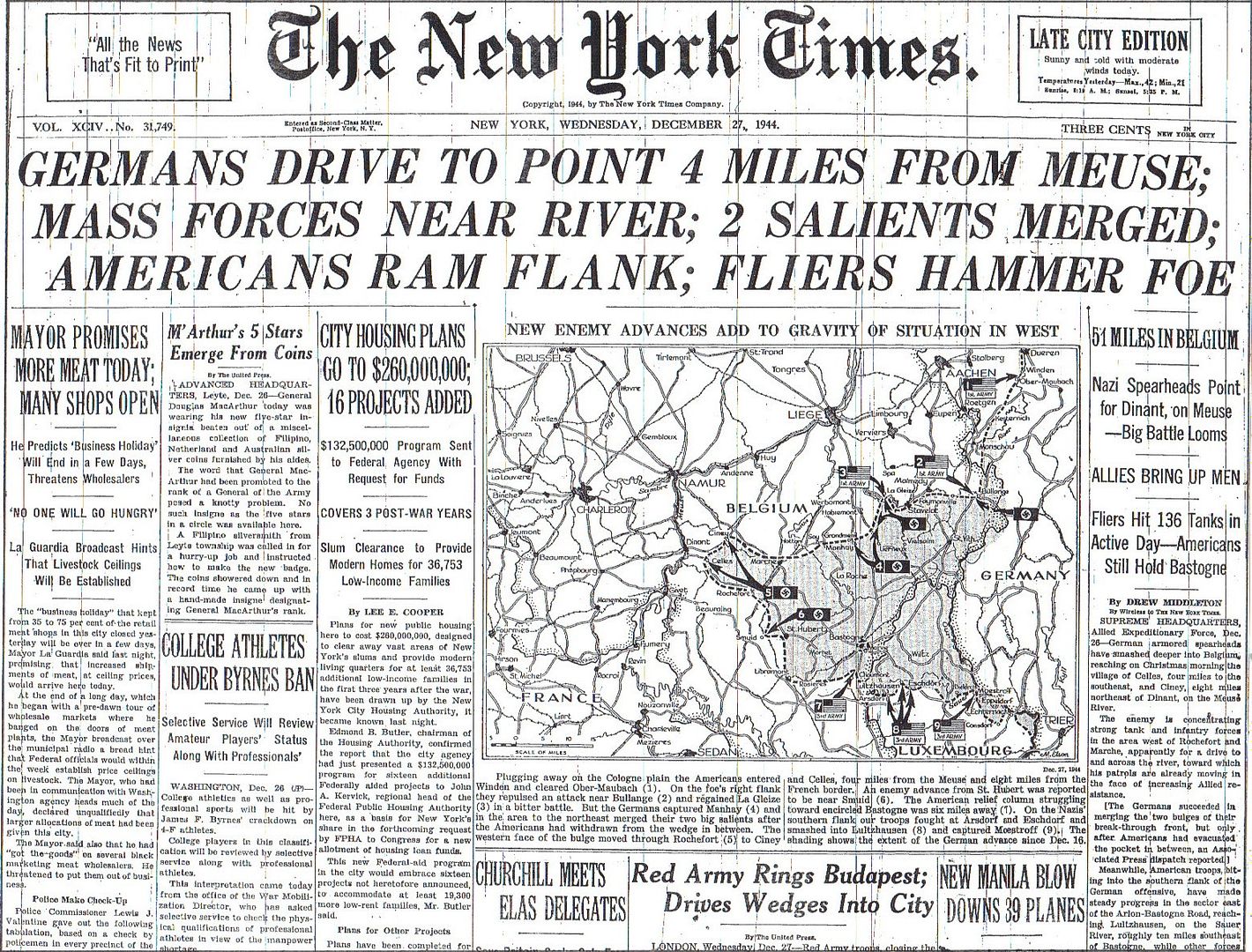
Posted on 12/27/2014 5:06:16 AM PST by Homer_J_Simpson


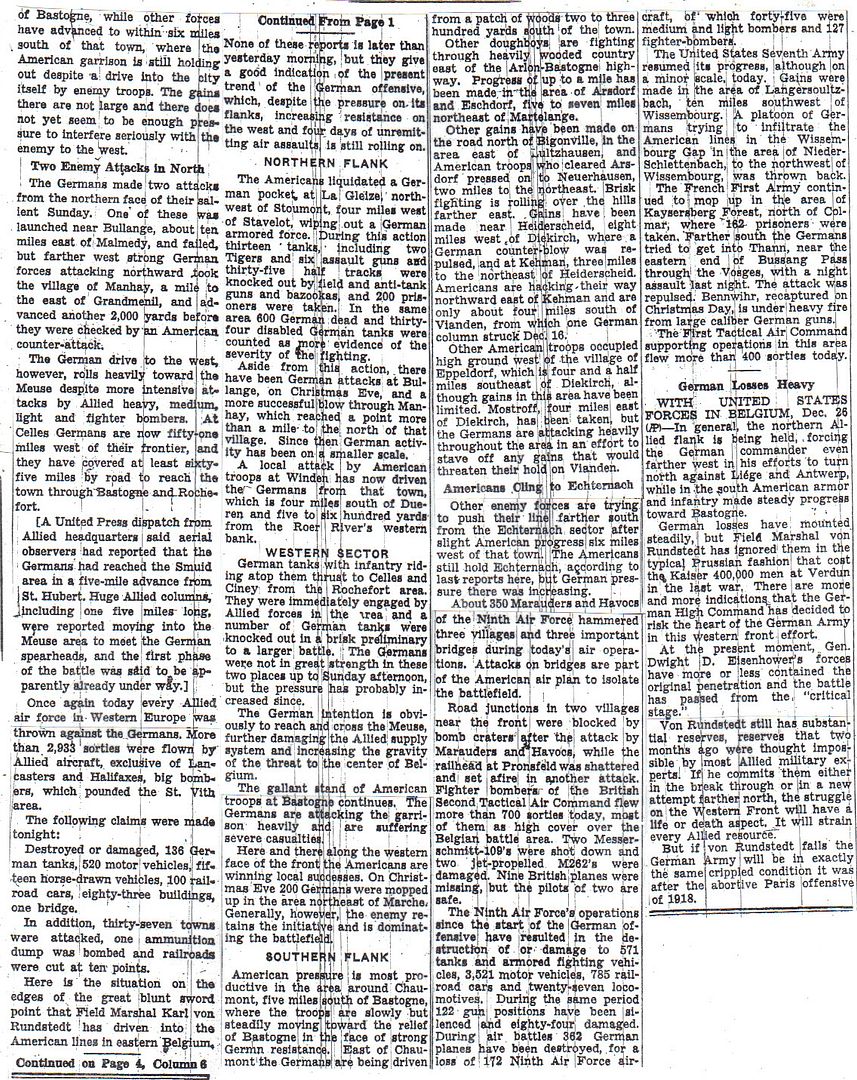
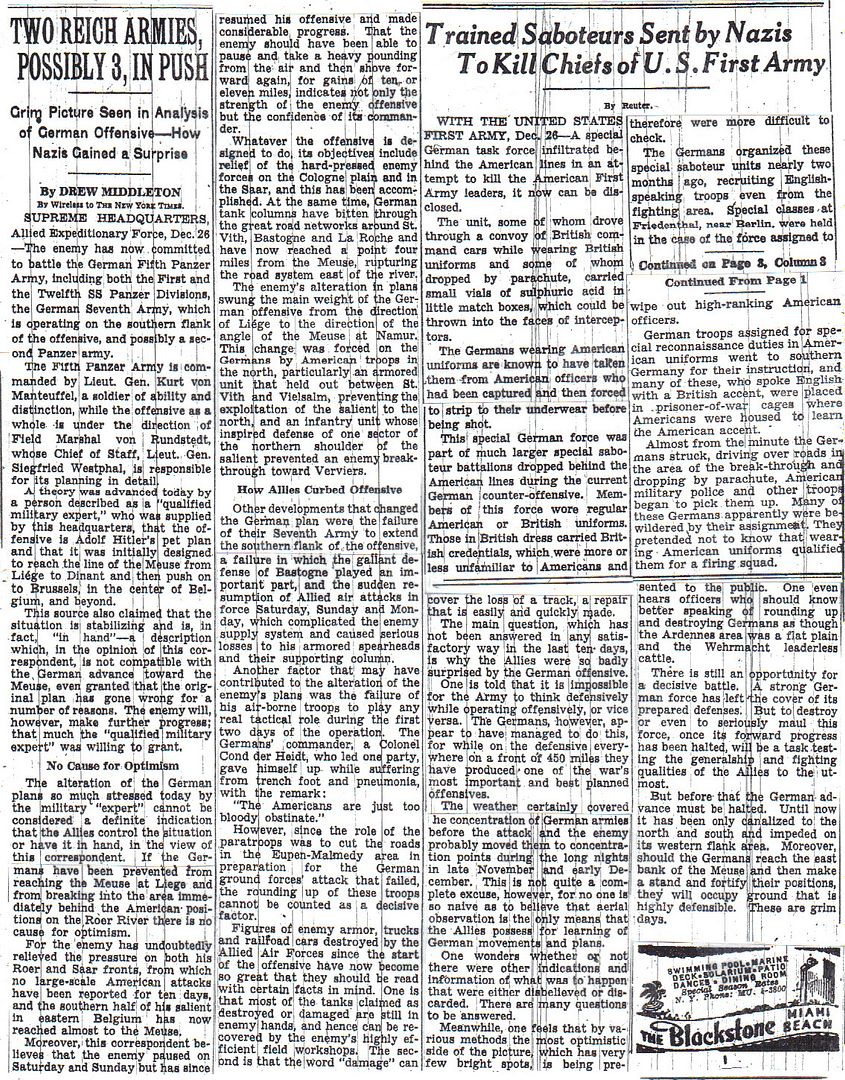
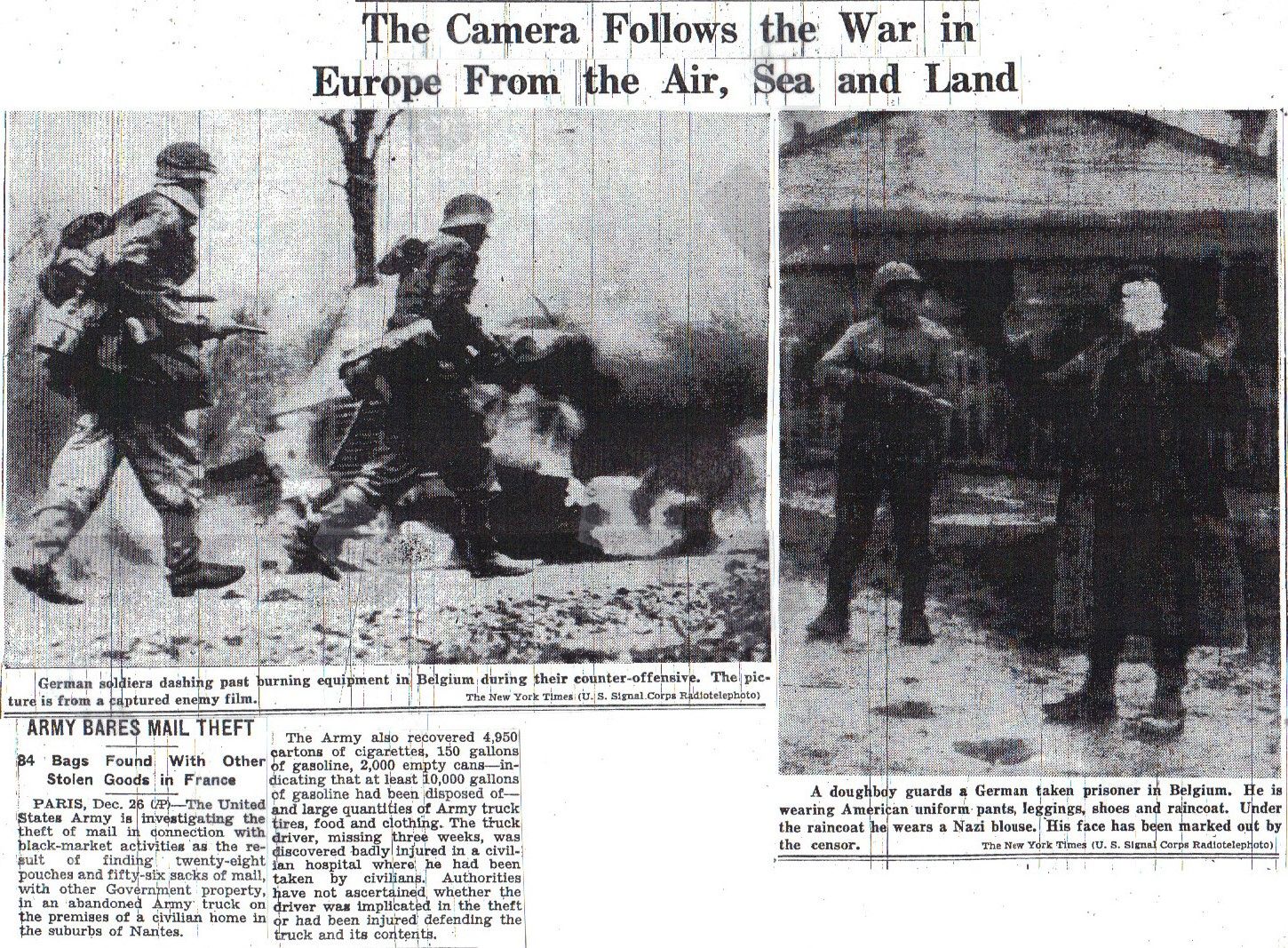

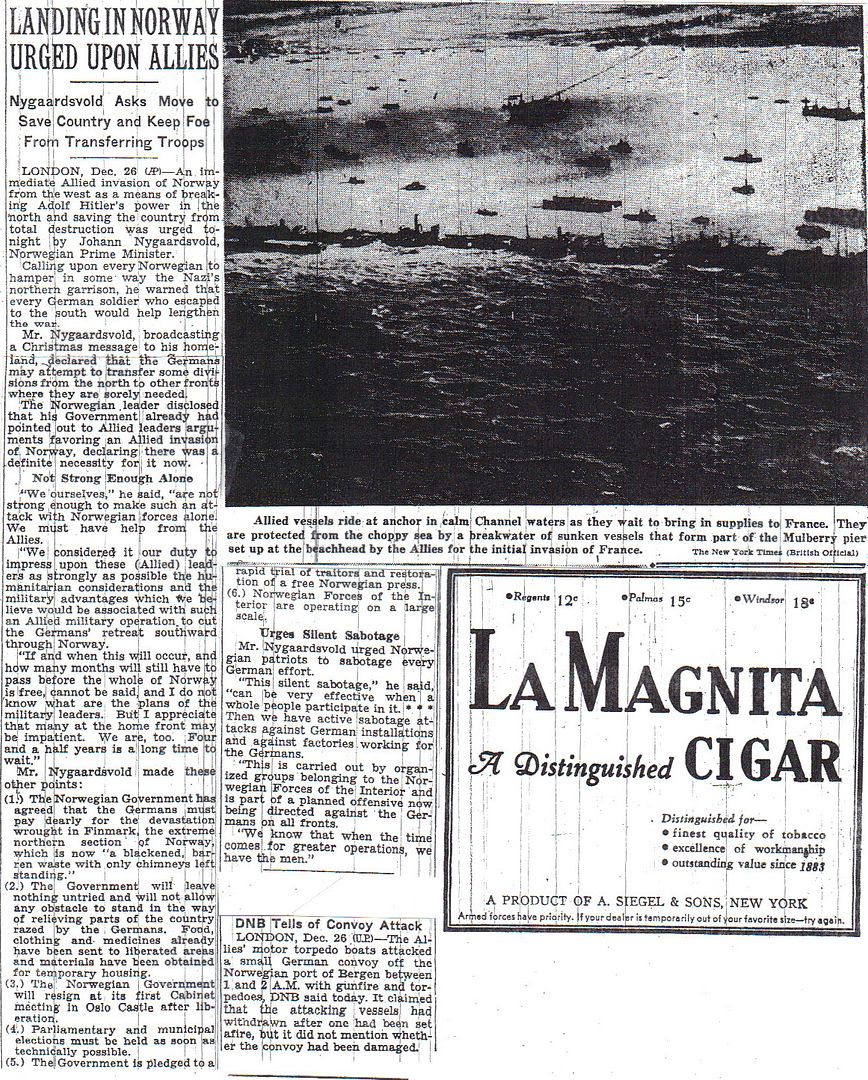
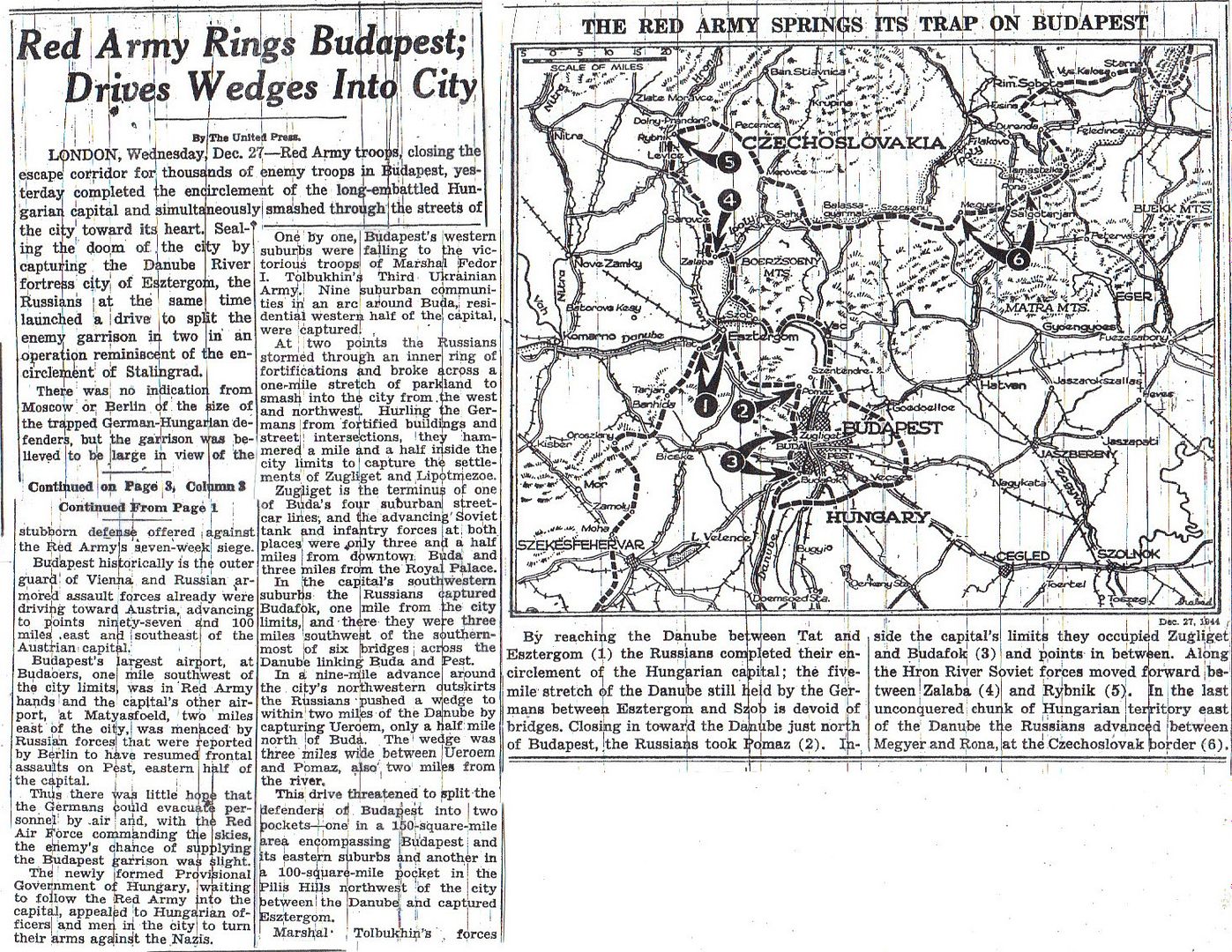
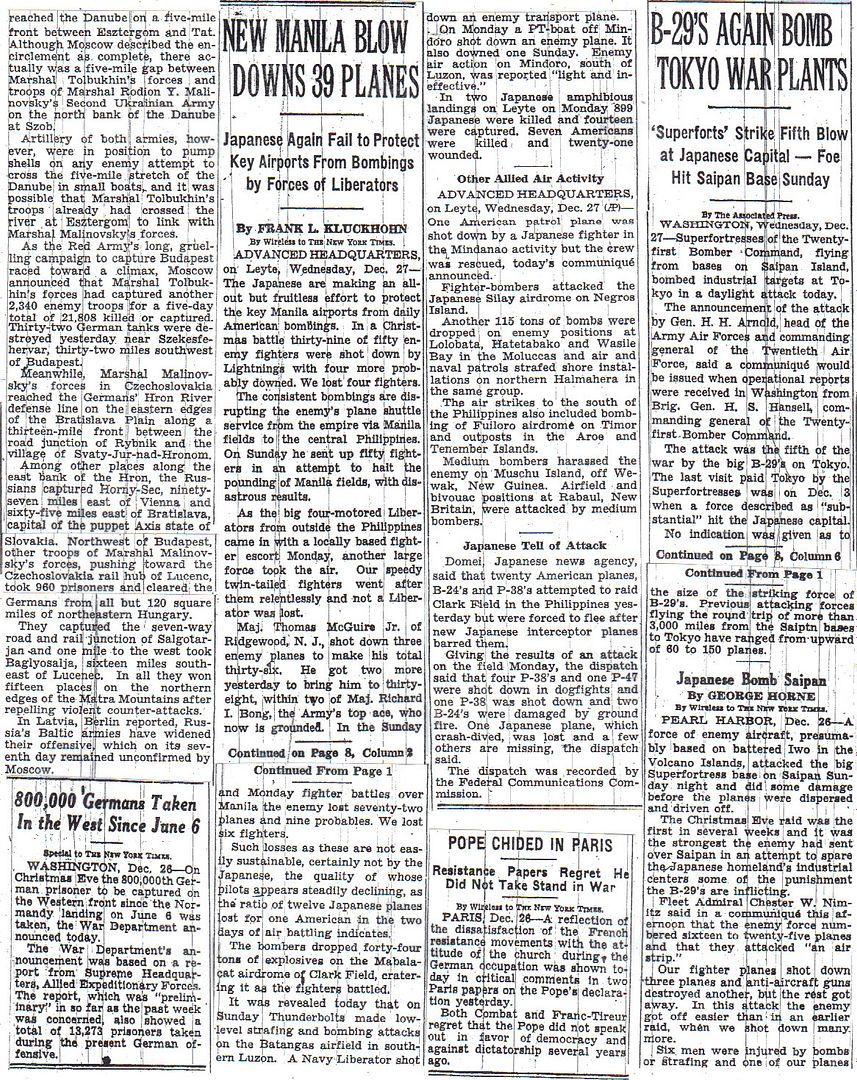

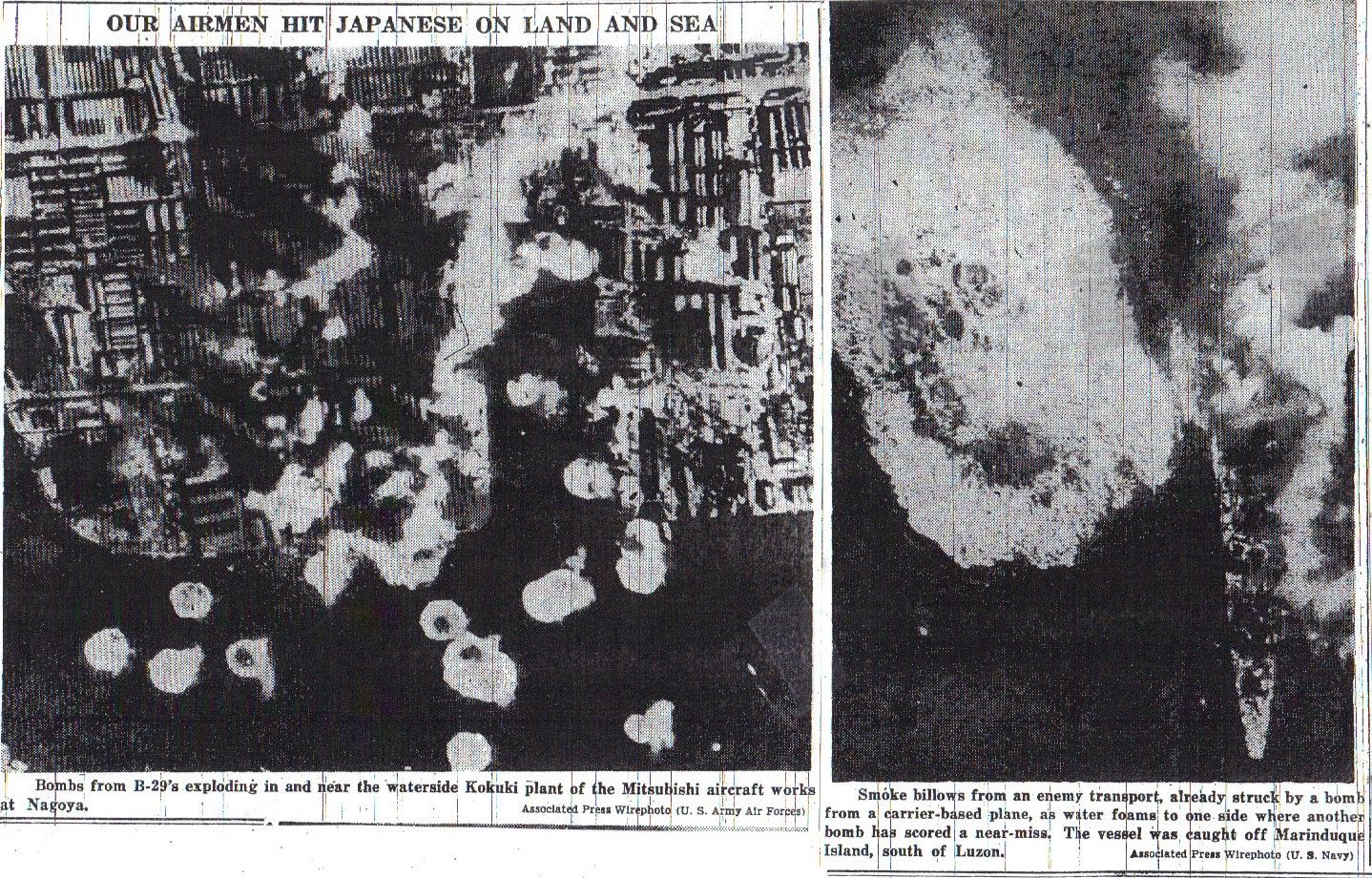
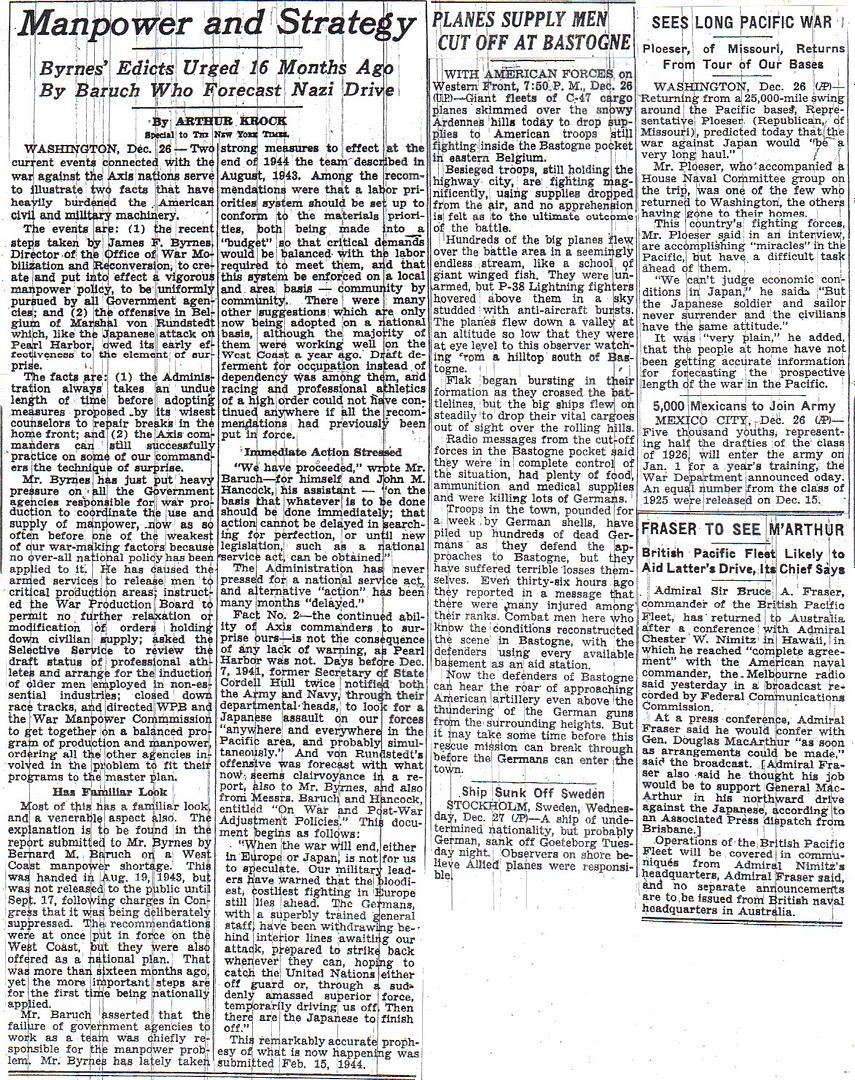
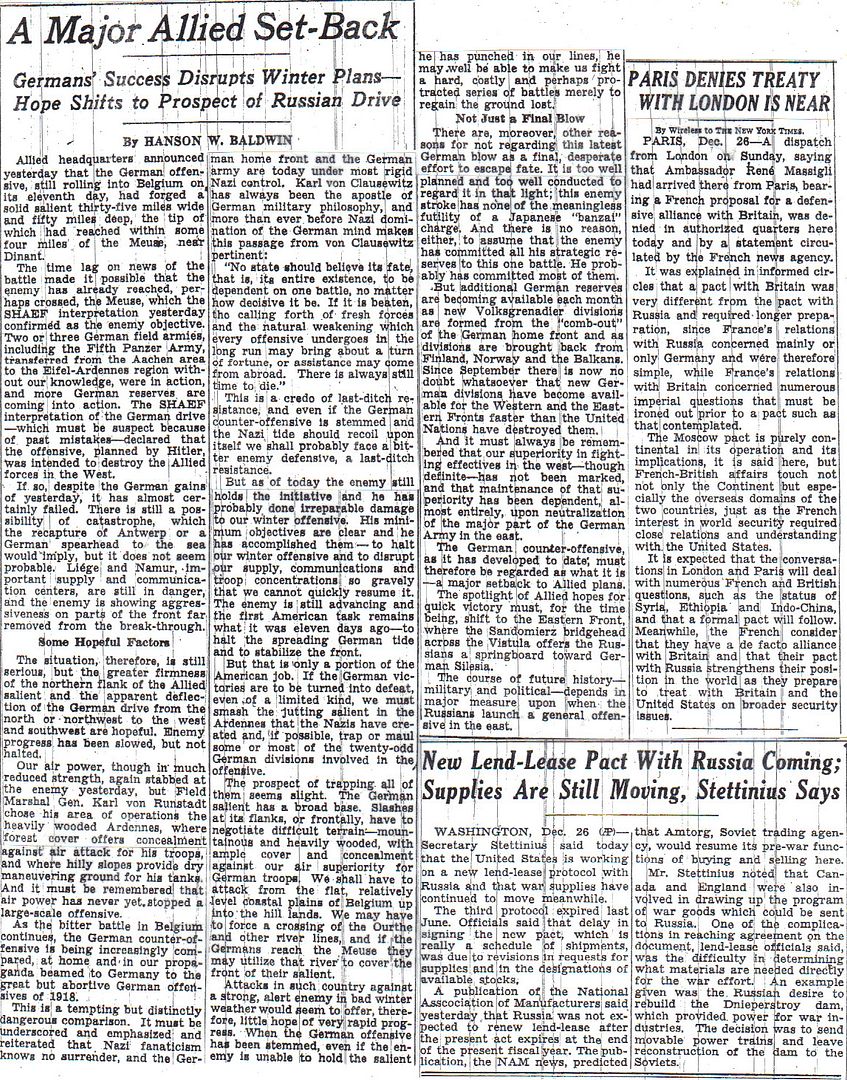
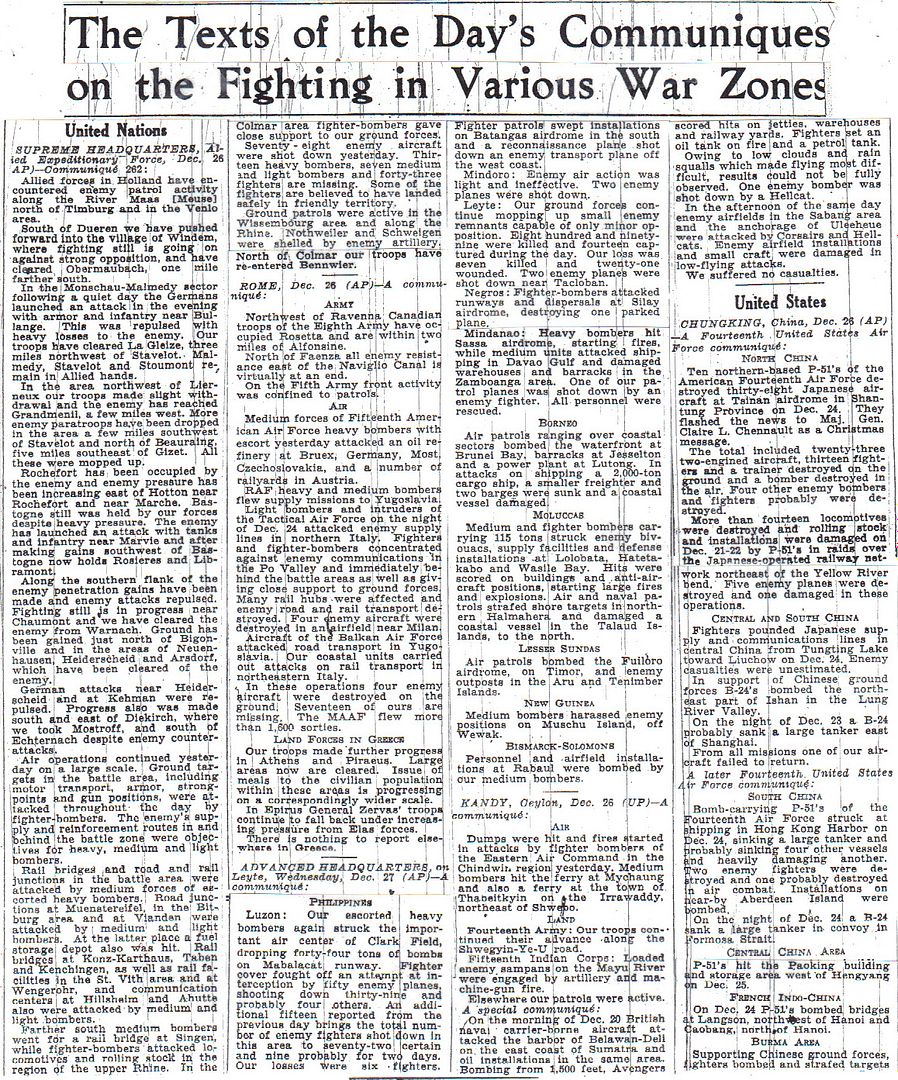
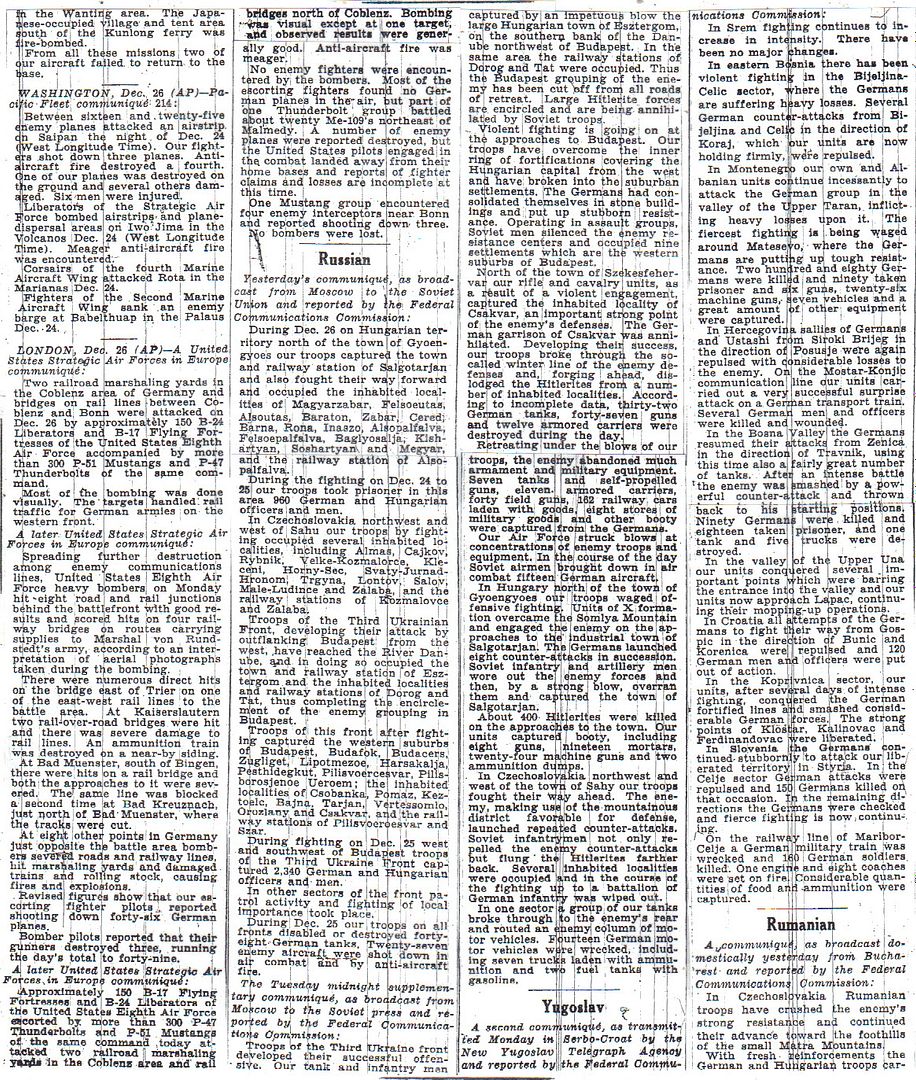
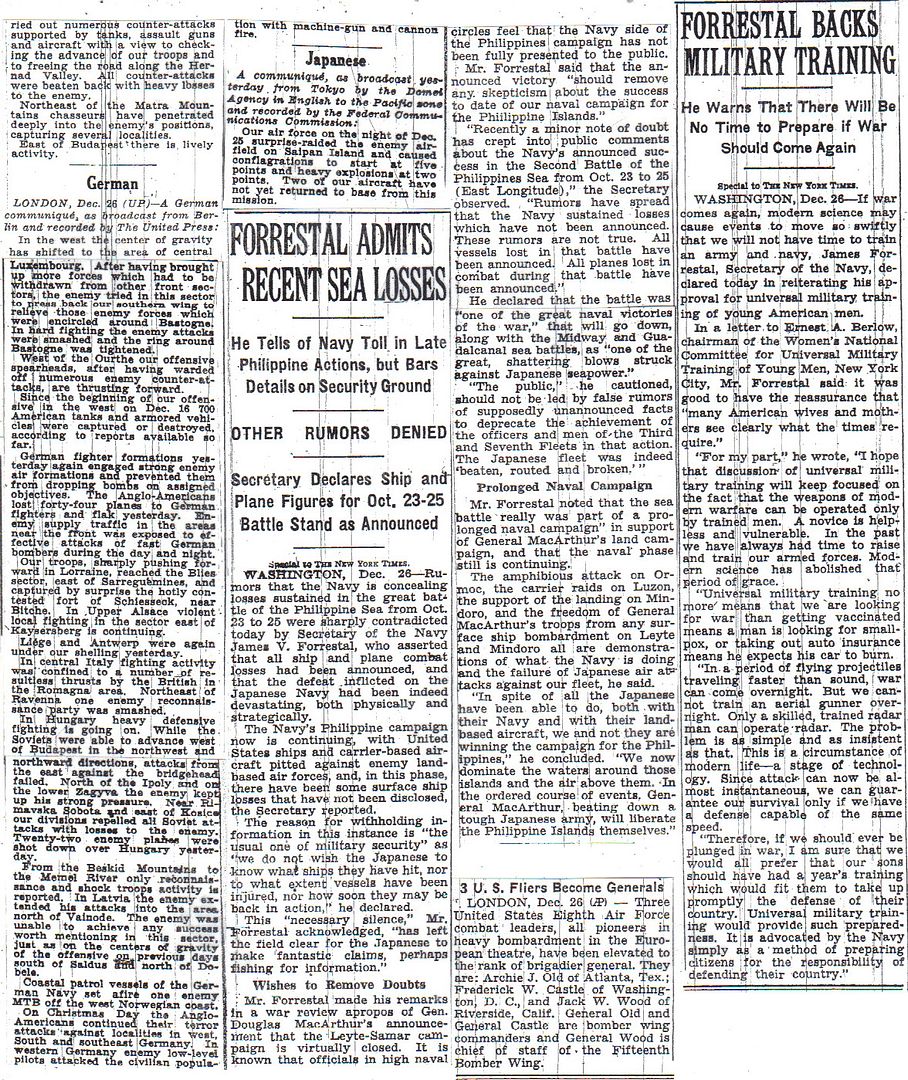
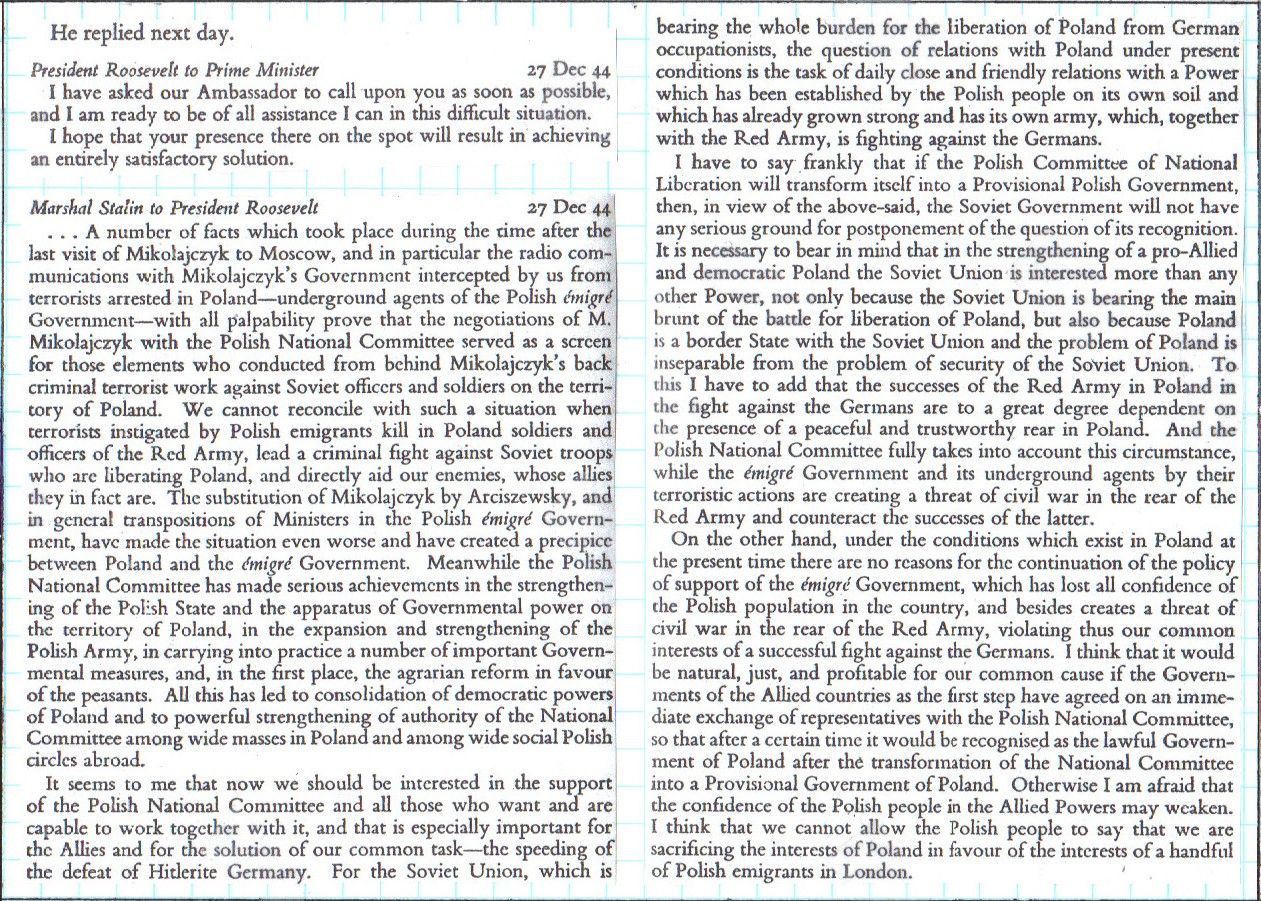
Winston S. Churchill, Triumph and Tragedy
http://www.etherit.co.uk/month/11/27.htm
December 27th, 1944 (WEDNESDAY)
WESTERN EUROPE: Medium and light bombers of the USAAF Ninth Air Force’s 9th Bombardment Division attack rail bridges, communications centers, and targets of opportunity in Belgium and Germany; fighters escort the bombers, fly patrols and armed reconnaissance, and support the U.S. 3d Armored and 82d Airborne Divisions in the Manhay and Trois-Ponts area of Belgium, and the III, VIII, and XII Corps in the Saint-Hubert-Bastogne-Martelange area of Belgium.
BELGIUM: The British XXX Corps advances into Celles and the German 2nd Panzer Division withdraws. This German division is far to the front of the other German divisions and will suffer from the Allied counterattacks.
The 3rd Royal Tank Regiment at Celles and the 23rd Hussars approximately five kilometres due south. Both of the 29th Armoured Brigade. RAF Typhoons had worked the area on 25 December and presented the Germans with rockets as Christmas gifts. (Jay Stone)
U.S. 7th Army units report very quiet in their areas.
For the sake of tight security, the only German Army officers briefed on “Operation Nordwind” were Division commanders and Operations Officers. German units were ordered to conduct minimum normal patrols and radio silence was imposed.
The plan adopted by Hitler called for two attacks with neither named as “the main attack” and no provision for armored exploitation. Both factors were contrary to German military doctrine. (Joe Brott)
Just outside Savy, Belgium, Jay Stone was in a Jeep driving around a steeply banked turn. He was on the lower part of the banked turn when a tank was entering on the high side. The tank began to slide toward the jeep and he thought “this is a hell of a way to go”, but either the tank got control or the jeep got out of there. (William Jay Stone)
In the U.S. First Army’s XVIII Corps (Airborne) area, the 30th Infantry Division maintains defensive positions while regrouping. The 508th Parachute Infantry Regiment, 82d Airborne Division, continues a drive northeast of Bra. The 7th Armored Division recaptures Manhay early in the day. The 9th Armored Division is reinforced by Regimental Combat Team 112 of the 28th Infantry Division. In the VII Corps area, the Germans are infiltrating toward Sadzot in the zone of Combat Command A, 3d Armored Division, where the front line is held by Regimental Combat Team 289. The 84th Infantry Division clears a pocket in the Verdenne area. Columns of the 2d Armored Division envelop Humain and clear stubborn resistance there. The 83d Infantry Division, upon closing in the Havelange area, begins relief of the 2d Armored Division.
In the U.S. Third Army’s VIII Corps area, the 17th Airborne Division takes over the Meuse River sector. In the III Corps area, trucks and ambulances roll into Bastogne on a road opened by Combat Command R, 4th Armored Division, ending the siege of the city. The 4th Armored Division and reinforcements from the 9th Armored and 80th Infantry Divisions are broadening the corridor to Bastogne and attempting to open the Arlon-Bastogne highway.
Twelve USAAF Eighth Air Force bombers attack communications centers at St. Vith during Mission 764.
FRANCE: In the U.S. Seventh Army area, units report very quiet in their areas. (Joe “Old Joe” Brott)
In the U.S. Seventh Army area, XXI Corps (36th Infantry and 12th Armored Divisions) arrives. VI Corps is reinforced by Task Force Harris (63d Infantry Division), Task Force Herren (70th Infantry Division), and Task Force Linden (42d Infantry Division).
LUXEMBOURG: In the U.S. Third Army’s III Corps area, From the south bank of the Sauer River, the 35th Infantry Division attacks northward between the 4th Armored and 26th Infantry Divisions, the 137th Infantry Regiment taking Surre and the 320th Infantry Regiment, Boulaide and Boschleiden. The 26th Infantry Division pushes northward through the 101st Airborne Infantry Division, clearing Mecher-Dunkrodt and Kaundorf. In the XII Corps area, the 80th Infantry Division checks an attack in the Ringel area and blocks roads north and northeast of Ettelbruck. The 6th Armored Division takes responsibility for the sector south of the Sauer River between Ettelbruck and Mostroff. Beaufort, north of Waldbillig, falls to the 11th Infantry Regiment, 5th Infantry Division. 4th Infantry Division patrols find Echternach undefended. In the XX Corps area, the 90th Infantry Division patrols aggressively and conducts raids to keep the Germans pinned down. The 5th Ranger Battalion is attached to 95th Infantry Division.
GERMANY: Briefings for Operation NORDWIND begin. [Operation Nordwind (North Wind) is an attack conducted by the Germans during January 1945 in Alsace and Lorraine, France.] For the sake of tight security, the only German Army officers briefed are division commanders and operations officers. German units are ordered to conduct minimum normal patrols and radio silence is imposed. The plan adopted by Chancellor Adolf Hitler calls for two attacks with neither named as “the main attack” and no provision for armored exploitation. Both factors are contrary to German military doctrine. (Joe “Old Joe” Brott)
The USAAF Eighth Air Force flies Mission 764: freezing fog at bases in the U.K. restrict operations but 641 bombers and 390 fighters are dispatched against rail targets in western Germany in support of the battlefront in the Bulge; two bombers are lost. The targets are (numbers in parenthesis indicate number of aircraft bombing and number lost, e.g., 97-1):
- Marshalling yards: Fulda (113-0), Euskirchen (73-0), Andernach (63-0), Gerolstein (58-0), Neuenkirchen (57-0), Homburg (45-0), Kaiserslautern (33-0), Lutzel M/Y at Koblenz (14-1), St. Wendel (9-0) and Bonn (1-0).
- Railroad bridges: Bullay (34-0), Altenahr (25-0), Kaiserslautern (15-1) and Neuweid (8-0).
Twenty two other aircraft bomb targets of opportunity. Fighter aircraft are also engaged: 163 P-47 Thunderbolts and P-51 Mustangs fly a fighter sweep and engage about 200 Luftwaffe fighters; they claim 29.5-1-9 aircraft; two P-51s are lost.
During the day, RAF Bomber Command dispatches 200 Lancasters and 11 Mosquitos to attack the marshalling yards at Rheydt; 191 bomb the target. One Lancaster is lost and a Mosquito crashes behind the Allied lines in the Netherlands.
During the night of 27/28 December, the USAAF Eighth Air Force flies Mission 765, a night leaflet mission over Germany.
During the night of 27/28 December, RAF Bomber Command dispatches 328 aircraft, 227 Halifaxes, 66 Lancasters and 35 Mosquitos, to bomb railroad shops at Opladen; 313 bomb the target with the loss of two Lancasters. Nine of the Mosquitos bombed 3.5 hours before the main raid. The aiming point for the attack is the marshalling yards but results are not known. Mosquitos are also active: 12 bomb Munster, seven bomb Frankfurt-am-Main and six bomb Hannover without loss.
HUNGARY: Budapest is completely encircled as elements of the Second Ukrainian Front clear an island in the Danube River north of the city and establish contact with the Third Ukrainian forces. Fighting is in progress in the eastern and western suburbs.
AUSTRIA: The USAAF Fifteenth Air Force dispatches over 520 B-17 Flying Fortresses and B-24 Liberators to attack various targets. The targets are (numbers in parenthesis indicate number of aircraft bombing and number lost, e.g., 97-1):
- Marshalling yards: Main M/Y at Linz (128-1), Klagenfurt (58-0), Main M/Y at Graz (53-1), South M/Y at Villach (18-0), Bruck (16-1) and Wiener Neustadt (7-1) and North M/Y at Villach (5-0).
- Oil refinery: Vosendorf refinery at Vienna (39-0).
- Others: 13 aircraft hit five targets.
Twenty nine P-51 Mustangs strafe railroad targets between Vienna and Linz while other fighters fly over 250 escort sorties.
ITALY: In the U.S. Fifth Army area, the first echelon of the 10th Mountain Division arrives. In the IV Corps area, the Germans force a further withdrawal of the 92d Infantry Division, but elements of Indian 8th Division pass through the 92d and make patrol contact with the Germans.
USAAF Twelfth Air Force medium bombers blast three Brenner area routes leading into Austria and Yugoslavia, and bomb two supply dumps in the Bologna area. Fighter-bombers devote their main effort to support the U.S. Fifth Army in the Serchio Valley area where counterattacks are being successfully halted; other fighter-bombers hit communications in the Po Valley and escort medium bombers and C-47s dropping supplies to Italian partisans. During the night of 27/28 December, A-20 Havocs bomb lights and motor transport at almost 50 places throughout the Po Valley and Brenner area.
USAAF Fifteenth Air Force B-24 Liberators attack railroad targets: 76 bomb the railroad viaduct at Venzone, 22 bomb a rail line in the Brenner Pass with the loss of one bomber, 17 bomb a railroad bridge at Bressanone and 13 hit a railroad bridge at Vipiteno. Forty four P-38 Lightnings bomb bridges at Latisana and Casarsa della Delizia.
During the day, 30 RAF bombers of No. 205 (Heavy Bomber) Group bomb the Susegana railroad bridge at Piave. During the night, two bombers drop leaflets over northern Italy.
YUGOSLAVIA: Sixty five USAAF Fifteenth Air Force B-24 Liberators bomb the Main marshalling yard at Maribor.
During the day, nine RAF bombers of No. 205 (Heavy Bomber) Group drop supplies to partisans.
CHINA: Six USAAF Fourteenth Air Force B-25 Mitchells bomb the area west of Kengtung while two B-25s and eight P-40s hit the Ishan area. Fighters are also active: 29 P-40s and P-51 Mustangs attack the area south of Puchi and 17 P-51s over White Cloud, Whampoa, and Tien Ho Airfields in Canton, claim ten airplanes destroyed with the loss of two P-51s.
BURMA: In the Northern Combat Area Command (NCAC) area, the U.S. 124th Cavalry Regiment (Special), upon completing its march to Momauk, begins reorganizing for combat.
In the British Fourteenth Army area, the XV Corps commander recommends that operations against Akyab be advanced to 3 January 1945.
Eight USAAF Tenth Air Force B-25 Mitchells attack bridges at Kin and Kyaukhlebein, damaging the former while 28 P-47 Thunderbolts hit troop and supply areas at Se-hai, Man Hkam, Mong Yok, and Mong Nge. Four B-25 Mitchells continue offensive reconnaissance against communications lines during the night of 27/28 December.
USAAF Fourteenth Air Force P-40s and P-51 Mustangs hit targets of opportunity at or near Lungan, Mong Long, and Namtao.
FRENCH INDOCHINA: USAAF Fourteenth Air Force P-40s and P-51 Mustangs hit targets of opportunity at or near Vinh, Yen, and Mong Khong and Kweiyi, China.
JAPAN: The USAAF Twentieth Air Force’s XXI Bomber Command flies Mission 16: 72 B-29 Superfortresses from the Mariana Islands are sent to bomb the Nakajima and Musashino aircraft plants in Tokyo; 39 hit the primary targets and 13 attack alternates and targets of opportunity. Japanese fighters are active, flying over 250 individual attacks and B-29 gunners claim 21-10-7 fighters. Three B-29s are lost, one to fighters and two to mechanical difficulties.
COMMONWEALTH OF THE PHILIPPINES: In the U.S. Eighth Army’s X Corps area on Leyte Island, Companies F and G, 34th Infantry Regiment, 24th Infantry Division, sail from Gigantangan Island. to Taglawigan, on the northwestern coast of Leyte Peninsula, and land without opposition, taking Taglawigan. They then proceed by sea and overland to Daha, which is also secured. Company G, reinforced, moves south by sea to the San Isidro area and goes ashore. The 1st Battalion, meanwhile, ordered to take San Isidro, moves overland from Calumbian to the heights overlooking the town. In the XXIV Corps area, the 3d Battalion, 305th Infantry Regiment, 77th Infantry Division, takes the heights 600 yards (549 meters) ahead as it continues west along the Palompon road against tenacious resistance. The 2d Battalion is to move forward by water. The 1st Battalion, 305th Infantry Regiment, remains in the Palompon area, patrolling and awaiting the rest of regiment.
USAAF Far East Air Forces B-24 Liberators bomb San Jose and Talisay Airfields on Negros Island and Matina Airfield on Mindanao Island.
EAST INDIES: Small miscellaneous strikes are carried out by the USAAF Far East Air Forces over Borneo, Celebes Islands, and the Lesser Sunda Islands.
BONIN AND VOLCANO ISLANDS: Forty eight Mariana Island based USAAF Seventh Air Force B-24 Liberators bomb Iwo Jima, Volcano Islands, while 21 more bomb Chichi Jima, Bonin Islands. P-38 Lightnings strafe the Iwo Jima airfields on which two B-24 Liberators also make snooper strikes during the night of 27/28 December.
USN Task Group 94.9, the heavy cruisers USS Chester (CA-27), Pensacola (CA-24) and Salt Lake City (CA-25) and seven destroyers, follows up the USAAF strikes with a bombardment of Japanese installations on Iwo Jima and shipping offshore. Destroyer USS Dunlap (DD-384) is damaged by shore battery, but not before she teams with USS Fanning (DD-385) and Cummings (DD-365) to sink a fast transport and a landing ship.
CANADA: Frigate HMCS Dunver completed refit Pictou, Nova Scotia.
U.S.A.:
Destroyer USS Willard Keith commissioned.
Destroyer escort USS Vandivier launched.
Heavy cruisers USS Norfolk nd Scranton laid down.
Destroyer USS James E Kyes laid down.
ATLANTIC OCEAN: Frigate HMCS Sea Cliff and corvettes HMCS Edmunston and St Thomas sank U-877 NW of Azores, 46-25N 36-38W while escorting convoy HX-327. U-877, a IXC/40 Type U-Boat built by Deutsche Schill und machinenbau, AG, Weser, Bremen, Launched 10 Dec 43, commissioned 24 Mar 44, in service 9 months, with no record of sinking any ships. One authority indicates U-877 was a IXC/42 type U-boat, however, Deutsche Schiff und Machinenbau AG, Weser, Bremen, never completed any of that type of U-boat. U-877’s, primary assigned task was as a weather reporting U-boat from the area west of Ireland, however, her wireless was faulty nd in view of the radio problems headed for North America. On 27 Dec radar warning set gave the alarm and U-877 crash-dived. Edmunston made initial Asdic contact that she soon abandoned as doubtful. St Thomas, coming up astern, obtained the contact and immediately fired one bomb from her squid mortar to ‘keep his head down’ St Thomas lined up and made a deliberate attack with one more Squid bomb, which exploded directly over U-877’s stern. Water poured into the U-boat causing her to sink to nearly 1,200 feet before ballast was blown nd she surfaced. Both St Thomas and Sea Cliff, who had joined to help, opened fire, but there was little fight left in U-877. By the time the two escorts closed, all the U-boat’s crew were safely in their life rafts. The number rescued were 5 officers, 4 senior rates, nd 46 junior rates.
When was the “Nuts” response? Have we already passed it and was it reported in the NYT or in another article I missed?
Stay tuned. There should be something before the end of the year.

Think how cold it is in those unheated, unpressurized B-17's.
50 below zero F. is not uncommon. Don’t take off your gloves unless you really need to.
Stalin was normally a very blunt man of few words. I’m surprised he didn’t just cut to the chase in his letter to FDR and say:
“The Red Army is going to occupy Poland and it’s bringing my puppet government with it. You just have to accept that’s going to happen.”
Notice in the articles by Drew Middleton and Hanson Baldwin that the intelligence failure finger pointing has started. Baldwin has already made comparisons to Pearl Harbor. Also somewhat chilling is Baldwin’s assertion that we will need the Soviets to bail us out.
From Atkinson’s The Guns at Last Light:
“Glory Has Its Price”
Time in the last week of December chose Eisenhower as its “Man of the Year.” A flattering cover portrait depicted the supreme commander flanked by American and British flags, with legions of soldiers stretching behind him into the middle distance. The honor rang a bit tinny given the current German salient in Allied territory, which now measured forty miles wide by sixty miles deep. U.S. losses in the last fortnight of December included almost 600 tanks, 1,400 jeeps, 700 trucks, 2,400 machine guns, 1,700 bazookas, 5,000 rifles, and 65,000 overcoats. The enemy had accumulated such a large American motor pool that pilots were ordered to bomb any column that included both Allied and German vehicles.
Of greater concern was a German armored spearhead ripping a seam between the U.S. VII Corps in the south and XVIII Airborne Corps in the north. Fatigue, dispersion, empty fuel tanks, and ammunition shortages impaired the enemy drive. In some instances. half a German brigade towed the other half, and ordnance trucks often had to make a four-night round trip drive to Bonn for Artillery shells. But on Christmas Day the 2nd Panzer Division was only five miles from Dinant, soon drawing near enough to the Meuse to draw fire from British tanks. Four divisions in Joe Collins’s VII Corps, now nearly 100,000 strong, were ordered to counterpunch on a fifty-mile front, with Major General Ernie Harmon’s 2nd Armored Division smashing into the enemy vanguard after a seventy-mile road march from the Roer River that took less than a day.
Savage fighting raged from the Salm to the Meuse for three days. As Typhoons and Lightnings screamed over the treetops at Foy-Notre Dame, just east of Dinant, Harmon’s tanks rumbled through a wood in nearby Celles, destroying or capturing 142 vehicles and taking nearly five hundred prisoners. On December 26, Manteuffel authorized survivors from 2nd Panzer to flee on foot, abandoning equipment from six battalions. Farther east, a British flame-throwing tank persuaded two hundred Germans to emerge with raised hands from a last stand chateau in Humain, while thirteen artillery battalions drove the 2nd SS Panzer out of Manhay. In confused fighting at Sadzot-known to GIs as Sad Sack-enemy crews mortared their own platoons; the engagement turned out to be Sixth Panzer Army’s last sally before Model ordered Dietrich onto the defensive.
Eisenhower for the past week had been looking for counteroffensive opportunities that would trap the overextended Germans and fulfill his ambition of annihilating enemy forces west of the Rhine. An Ultra intercept decoded just after Christmas revealed that Model’s army group was fast running short of serviceable tanks and assault guns; despite recent losses, the U.S. First, Third, and Ninth Armies alone had almost four thousand tanks. But disagreements over when and where to strike back divided Allied commanders.
Patton favored driving from the south through to base of the German salient, toward Bitburg and then east, in hopes of bagging the entire enemy pocket. Collins, in a memorandum on Wednesday, December 27, laid out three options and endorsed “Plan No. 2,” a strong attack from the north toward St.-Vith, complemented by Third Army’s lunge from the south. Montgomery hesitated, suspecting the Rundstedt had enough combat strength for another attack that could punch through the Americans to Liege. Collins thought not. “Nobody is going to break through these troops,” he told Montgomery. :This isn’t going to happen.” If the Allies failed to attack closer to the base of the salient, they risk leaving a corridor through which retreating Germans could escape, he told the field marshal. “You’re going to push the Germans out of the bag,” Collins added, “just like you did at Falaise.”
Falaise could hardly be blamed solely on Montgomery, who through much of the European campaign had evinced a bold streak-in Market-Garden, for instance, and in encouraging the Americans to blow past the Brittany cul-de-sac. But now he turned cautious, perhaps discouraged by First Army’s early drubbing. He had doubted Patton’s ability to reach Bastogne or impede Manteuffel, and he doubted that the poor roads leading south towards St.-Vith would support Collin’s scheme. Rather than gamble on an attempt by First and Third Armies to sever the forty-mile base of the salient, he thought a more prudent counterstrike would aim the two armies’ main blows across the waist of the bulge at Houffalize, north of Bastogne, shooing away the enemy rather than trapping him, and only after the German offensive had, as he put it, “definitely expended itself.”
Eisenhower chafed at Montgomery’s caution. When he learned on Wednesday that the filed marshal was at last ready to consider counterattacking, the supreme commander exclaimed sarcastically, “Praise God from whom all blessings flow!”
“Monty is a tired little fart,” Patton informed his diary the same day. “War requires the taking of risks and he won’t take them.” Yet others were just as circumspect as Montgomery. Beetle Smith in a staff meeting on Wednesday suggested telling “our masters in Washington that if they wanted us to win the war over here they must find us another ten divisions.” Bradley also favored pinching the enemy at Houffalize, not least because Eisenhower had promised to return First Army to his command when the town fell. First Army planners agreed that poor roads precluded hitting at the base of the Ardennes salient, and Monk Dickson, the intelligence chief, endorsed Montgomery’s view the Rundstedt could strike again; he counted seventeen uncommitted German divisions. Deteriorating weather further encouraged prudence: a five-day spell of clear skies ended on Thursday, December 28, and with it the comfort provided by Allied air fleets.
Joe Collins should have commanded 1st Army instead of Hodges.
Maybe Stalin’s note was ghost-written by someone who thought he’d get more points for more words.
That might well be.
He could have just said “possession is 9/10ths of the law” and left it at that.
“When was the “Nuts” response? Have we already passed it and was it reported in the NYT or in another article I missed?”
Yes, you missed it. Look back at the 22nd to 24th for details including the orginal letter from the German commander.
They reported it yesterday. They said that there was a one word answer from the American Commander: “No”.
Gotta link or date/page number?
Gotta link or date/page number?”
No. Go back to Homer’s threads for those days. I find old threds by clciking on his namebat the top and then clicking on the “In Forum” link at the top of the page. It will take you to all of his posts and you can peruses there for the relelvant thread.
Disclaimer: Opinions posted on Free Republic are those of the individual posters and do not necessarily represent the opinion of Free Republic or its management. All materials posted herein are protected by copyright law and the exemption for fair use of copyrighted works.